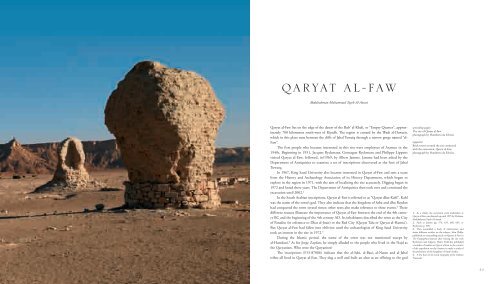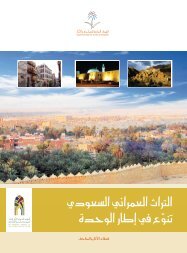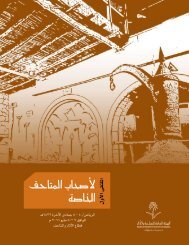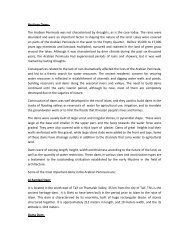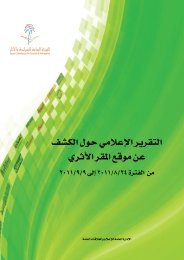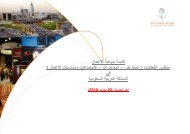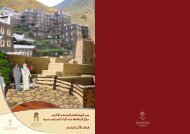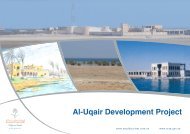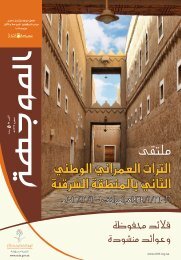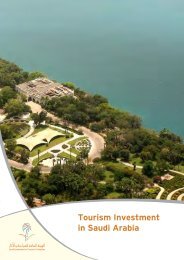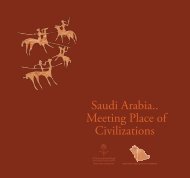Roads of Arabia
Roads of Arabia
Roads of Arabia
You also want an ePaper? Increase the reach of your titles
YUMPU automatically turns print PDFs into web optimized ePapers that Google loves.
18 Arabie US p308-317_BAT.qxd 23/06/10 22:05 Page 310<br />
QARYAT AL-FAW<br />
Abdulrahman Muhammad Tayeb Al-Ansari<br />
Qaryat al-Faw lies on the edge <strong>of</strong> the desert <strong>of</strong> the Rub‘ al-Khali, or “Empty Quarter”, approximately<br />
700 kilometres south-west <strong>of</strong> Riyadh. The region is crossed by the Wadi al-Dawasir,<br />
which in this place runs between the cliffs <strong>of</strong> Jabal Tuwaiq through a narrow gorge named “al-<br />
Faw”.<br />
The first people who became interested in this site were employees <strong>of</strong> Aramco in the<br />
1940s. Beginning in 1951, Jacques Ryckmans, Gonzague Ryckmans and Philippe Lippens<br />
visited Qaryat al-Faw, followed, in/1969, by Albert Jamme. Jamme had been asked by the<br />
Department <strong>of</strong> Antiquities to examine a set <strong>of</strong> inscriptions discovered at the foot <strong>of</strong> Jabal<br />
Tuwaiq.<br />
In 1967, King Saud University also became interested in Qaryat al-Faw and sent a team<br />
from the History and Archaeology Association <strong>of</strong> its History Department, which began to<br />
explore in the region in 1971, with the aim <strong>of</strong> localizing the site accurately. Digging began in<br />
1972 and lasted three years. The Department <strong>of</strong> Antiquities then took over and continued the<br />
excavation until 2002. 1<br />
In the South <strong>Arabia</strong>n inscriptions, Qaryat al-Faw is referred to as “Qaryat dhat Kahl”. Kahl<br />
was the name <strong>of</strong> the town’s god. They also indicate that the kingdom <strong>of</strong> Saba and dhu Raydan<br />
had conquered the town several times; other texts also make reference to these events. 2 These<br />
different sources illustrate the importance <strong>of</strong> Qaryat al-Faw between the end <strong>of</strong> the 4th century<br />
BC and the beginning <strong>of</strong> the 4th century AD. Its inhabitants described the town as the City<br />
<strong>of</strong> Paradise (in reference to Dhat al-Jnan) or the Red City (Qaryat Talu or Qaryat al-Hamra’).<br />
But Qaryat al-Faw had fallen into oblivion until the archaeologists <strong>of</strong> King Saud University<br />
took an interest in the site in 1972. 3<br />
During the Islamic period, the name <strong>of</strong> the town was not mentioned except by<br />
al-Hamdani. 4 As for Jorge Zaydan, he simply alluded to the people who lived in the Najd as<br />
the Qaryanites. Who were the Qaryanites?<br />
The inscriptions (F15-87086) indicate that the al-Sabi, al-Baai, al-Naten and al-Jabal<br />
tribes all lived in Qaryat al-Faw. They dug a well and built an altar as an <strong>of</strong>fering to the god<br />
(preceding pages)<br />
The site <strong>of</strong> Qaryat al-Faw,<br />
photograph by Humberto da Silveira<br />
(opposite)<br />
Brick towers around the site connected<br />
with the excavation, Qaryat al-Faw,<br />
photograph by Humberto da Silveira.<br />
1. As a whole, the excavation work undertaken at<br />
Qaryat al-Faw was directed up until 1995 by Pr<strong>of</strong>essor<br />
Abdulrahman Tayeb Al-Ansari.<br />
2. Such as Jamme pp. 576, 635, 660, 665, or<br />
Ryckmans p. 509.<br />
3. They assembled a body <strong>of</strong> information and<br />
wrote different articles on the subject. John Philby<br />
published an outstanding article on Qaryat al-Faw in<br />
The Geographical Journal after visiting the site with<br />
Ryckmans and Lippens. Henry Field also published<br />
a number <strong>of</strong> studies on Qaryat al-Faw in the context<br />
<strong>of</strong> the expedition sent by Aramco to make a study <strong>of</strong><br />
the prehistory <strong>of</strong> the kingdom <strong>of</strong> Saudi <strong>Arabia</strong>.<br />
4. A few lines in his work Geography <strong>of</strong> the <strong>Arabia</strong>n<br />
Peninsula.<br />
311


